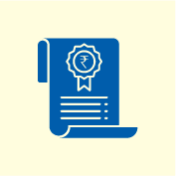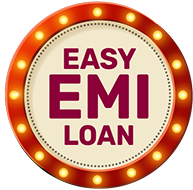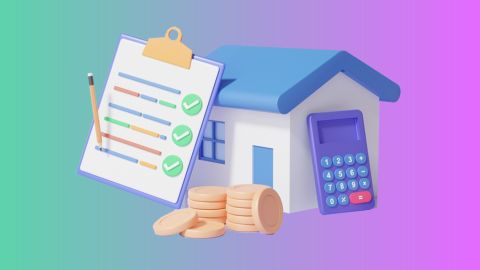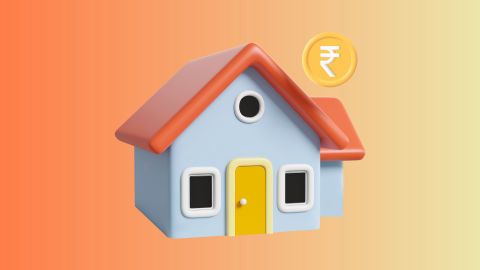Refinancing your mortgage can be a strategic financial decision, especially if you are looking to reduce your interest rates or monthly payments. The process of a refinance mortgage involves replacing your current home loan with a new one, usually with better terms. By refinancing, you can take advantage of lower interest rates or change the type of mortgage you hold. This can significantly impact your financial health and provide more flexibility in managing your finances. For instance, if you currently have a high-interest mortgage, refinancing can lower your rate, resulting in substantial savings over time.
Bajaj Finance offers Loan Against Property that can be an excellent option for refinancing your mortgage. With competitive interest rates and flexible repayment options, it allows you to leverage your property's value for better financial management.
What is a refinance mortgage?
A refinance mortgage is a financial strategy where you replace your existing mortgage with a new one, often with better terms. This can involve securing a lower interest rate, adjusting the loan term, or switching from an adjustable-rate mortgage to a fixed-rate mortgage. The primary goal of refinancing is to improve your financial situation by making your mortgage more affordable or aligning it better with your current financial goals.
When you refinance, you essentially pay off your old mortgage with the new one. This process may involve closing costs, but the long-term savings can outweigh these initial expenses. Refinancing can be particularly beneficial if market conditions have changed since you took out your original loan, offering lower rates or better terms.
Benefits of refinancing your mortgage
- Lower interest rates: Refinancing can help you secure a lower interest rate, reducing your monthly payments and overall interest paid.
- Reduced monthly payments: By obtaining a lower rate or extending your loan term, you can decrease your monthly mortgage payments, freeing up cash for other expenses.
- Shorter loan term: Refinancing can allow you to shorten your loan term, enabling you to pay off your mortgage faster and save on interest.
- Switch loan types: You can switch from an adjustable-rate mortgage (ARM) to a fixed-rate mortgage, providing more stability in your payments.
- Cash-out option: Refinancing can provide access to your home equity through a cash-out refinance, giving you funds for home improvements, debt consolidation, or other financial needs.
How to refinance your mortgage?
Refinancing your mortgage involves several steps, starting with evaluating your current financial situation and understanding your goals. Begin by checking your credit score, as it will impact your ability to secure a favourable rate. Next, research different lenders and compare their offers to find the best terms for your refinance mortgage.
Once you have chosen a lender, you will need to gather necessary documents, such as proof of income, tax returns, and information about your current mortgage. The lender will review your application, and if approved, you will go through the closing process, similar to your original mortgage. This will involve paying closing costs and signing new loan documents.
Steps to refinance mortgage process
Step |
Description |
1. Evaluate finances |
Assess your credit score, current loan terms, and financial goals. |
2. Research lenders |
Compare offers from different lenders to find the best rates. |
3. Apply for loan |
Submit the necessary documents and complete the application process. |
4. Appraisal |
A lender appraises your property to determine its current value. |
5. Underwriting |
Lender reviews your financials and property appraisal. |
6. Closing |
Sign new loan documents and pay closing costs to finalise the refinance. |
Types of refinance mortgages
- Rate-and-term refinance: Adjusts the interest rate or loan term without changing the loan balance.
- Cash-out refinance: Allows you to borrow against your home equity, receiving cash at closing.
- Cash-in refinance: Involves paying down the loan balance to qualify for a lower loan-to-value ratio and better terms.
- Streamline refinance: Simplified refinancing process available for government-backed loans like FHA, VA, or USDA loans.
Fixed-rate vs. adjustable-rate refinance
A fixed-rate refinance mortgage offers a consistent interest rate throughout the loan term, providing predictable monthly payments. This can be advantageous if you prefer stability and long-term planning. On the other hand, an adjustable-rate mortgage (ARM) refinance starts with a lower rate that adjusts periodically based on market conditions. While ARMs can initially offer lower payments, they come with the risk of increasing rates over time.
Cash-out refinance
A cash-out refinance allows you to tap into your home equity by refinancing for a higher loan amount than your current mortgage. The difference is paid out to you in cash, which can be used for various financial needs, such as home improvements, debt consolidation, or investing. This type of refinance can be a smart way to access funds while potentially securing better loan terms.
Conclusion
Refinancing your mortgage can provide significant financial benefits, from lowering your interest rates to reducing monthly payments. By understanding the different types of refinance mortgages and the steps involved, you can make informed decisions that align with your financial goals. Whether you are looking for stability with a fixed-rate mortgage or need funds through a cash-out refinance, options like Bajaj Finserv Loan Against Property can help you achieve your objectives.









 Food & Beverages
Food & Beverages Grocery
Grocery Fashion
Fashion Beauty & Personal Care
Beauty & Personal Care Health & Wellness
Health & Wellness Home & Kitchen
Home & Kitchen
 Loan Against Shares
Loan Against Shares Loan Against Mutual Funds
Loan Against Mutual Funds Loan Against Bonds
Loan Against Bonds Loan Against Insurance Policy
Loan Against Insurance Policy ESOP Financing
ESOP Financing Two-wheeler Loan
Two-wheeler Loan Loan for Lawyer
Loan for Lawyer Industrial Equipment Finance
Industrial Equipment Finance Industrial Equipment Balance Transfer
Industrial Equipment Balance Transfer Industrial Equipment Refinance
Industrial Equipment Refinance Easy EMI Loan
Easy EMI Loan
 Smartphones
Smartphones Air Conditioner
Air Conditioner Led TVs
Led TVs Air Coolers
Air Coolers Refrigerators
Refrigerators Washing Machines
Washing Machines Laptops
Laptops

 Trading Account
Trading Account Open Demat Account
Open Demat Account Margin Trading Financing
Margin Trading Financing Share Market
Share Market Invest in IPO
Invest in IPO All stocks
All stocks Top gainers
Top gainers Top losers
Top losers 52 week high
52 week high 52 week low
52 week low
 Business Loan
Business Loan Secured Business Loan
Secured Business Loan Loan against property
Loan against property Loans against property balance transfer
Loans against property balance transfer Loan against shares
Loan against shares Home Loan
Home Loan Loans against mutual funds
Loans against mutual funds Loan against bonds
Loan against bonds Loan against insurance policy
Loan against insurance policy
 Term Life Insurance
Term Life Insurance ULIP Plan
ULIP Plan Savings Plan
Savings Plan Retirement Plans
Retirement Plans Child Plans
Child Plans Investment Plans
Investment Plans
 Get Bajaj Prime
Get Bajaj Prime
 ULIP Plan
ULIP Plan Savings Plan
Savings Plan Retirement Plans
Retirement Plans Child Plans
Child Plans Free Demat Account
Free Demat Account Invest in IPO
Invest in IPO Invest in Stocks
Invest in Stocks Margin Trading Facility
Margin Trading Facility
 Check your Credit Score
Check your Credit Score
 Bike
Bike Scooter
Scooter Electric Vehicle
Electric Vehicle Best Sellers
Best Sellers Popular Brands
Popular Brands
 New Car Loan
New Car Loan Used Car Loan
Used Car Loan Loan Against Car
Loan Against Car Car Loan Balance Transfer and Top-up
Car Loan Balance Transfer and Top-up
 Engagement Zone
Engagement Zone Game Zone
Game Zone
 Personal Loan EMI Calculator
Personal Loan EMI Calculator Personal Loan Eligibility Calculator
Personal Loan Eligibility Calculator Home Loan EMI Calculator
Home Loan EMI Calculator Home Loan Eligibility Calculator
Home Loan Eligibility Calculator Good & Service Tax (GST) Calculator
Good & Service Tax (GST) Calculator Flexi Day Wise Interest Calculator
Flexi Day Wise Interest Calculator Flexi Transaction Calculator
Flexi Transaction Calculator Secured Business Loan Eligibility Calculator
Secured Business Loan Eligibility Calculator Fixed Deposits Interest Calculator
Fixed Deposits Interest Calculator Two wheeler Loan EMI Calculator
Two wheeler Loan EMI Calculator New Car Loan EMI Calculator
New Car Loan EMI Calculator Used Car Loan EMI Calculator
Used Car Loan EMI Calculator All Calculator
All Calculator
 Hot Deals
Hot Deals Clearance Sale
Clearance Sale Kitchen Appliances
Kitchen Appliances Tyres
Tyres Camera & Accessories
Camera & Accessories Mattresses
Mattresses Furniture
Furniture Watches
Watches Music & Audio
Music & Audio Cycles
Cycles Mixer & Grinder
Mixer & Grinder Luggage & Travel
Luggage & Travel Fitness Equipment
Fitness Equipment Fans
Fans
 Personal Loan for Doctors
Personal Loan for Doctors Business loan for Doctors
Business loan for Doctors Medical Equipment Finance
Medical Equipment Finance Secured Business Loan
Secured Business Loan Loan against property
Loan against property Loan against share
Loan against share Gold Loan
Gold Loan Home Loan
Home Loan
 Smartphones
Smartphones Air Conditioners
Air Conditioners LED TVs
LED TVs Air Coolers
Air Coolers Refrigerators
Refrigerators Washing Machines
Washing Machines Laptops
Laptops Water Purifiers
Water Purifiers Tablets
Tablets Kitchen Appliances
Kitchen Appliances Mattresses
Mattresses Furniture
Furniture Music and Audio
Music and Audio Cameras & Accessories
Cameras & Accessories Cycle
Cycle Watches
Watches Tyres
Tyres Luggage & Travel
Luggage & Travel Fitness Equipment
Fitness Equipment
 Home Loan
Home Loan Transfer your existing Home loan
Transfer your existing Home loan Loan against Property
Loan against Property Home Loan for Salaried
Home Loan for Salaried Home loan for self employed
Home loan for self employed Home Loan EMI Calculator
Home Loan EMI Calculator Home Loan eligibility calculator
Home Loan eligibility calculator Home Loan balance transfer
Home Loan balance transfer
 Offer World
Offer World
 Articles
Articles
 Overdue Payments
Overdue Payments Other Payments
Other Payments
 Document Center
Document Center Bank details & Documents
Bank details & Documents Tax Invoice Certificate
Tax Invoice Certificate
 Do Not Call Service
Do Not Call Service
 Your Orders
Your Orders Hamara Mall Orders
Hamara Mall Orders

 Fixed Deposit (IFA) Partner
Fixed Deposit (IFA) Partner Loan (DSA) Partner
Loan (DSA) Partner Debt Management Partner
Debt Management Partner EMI Network Partner
EMI Network Partner Become a Merchant
Become a Merchant Partner Sign-in
Partner Sign-in
 Food & Shopping
Food & Shopping Credit Card Hub
Credit Card Hub ULIP Plans
ULIP Plans Top Gainers Stock
Top Gainers Stock Top Losers Stock
Top Losers Stock Saving Plan
Saving Plan Term Insurance
Term Insurance
 Live Videos
Live Videos








